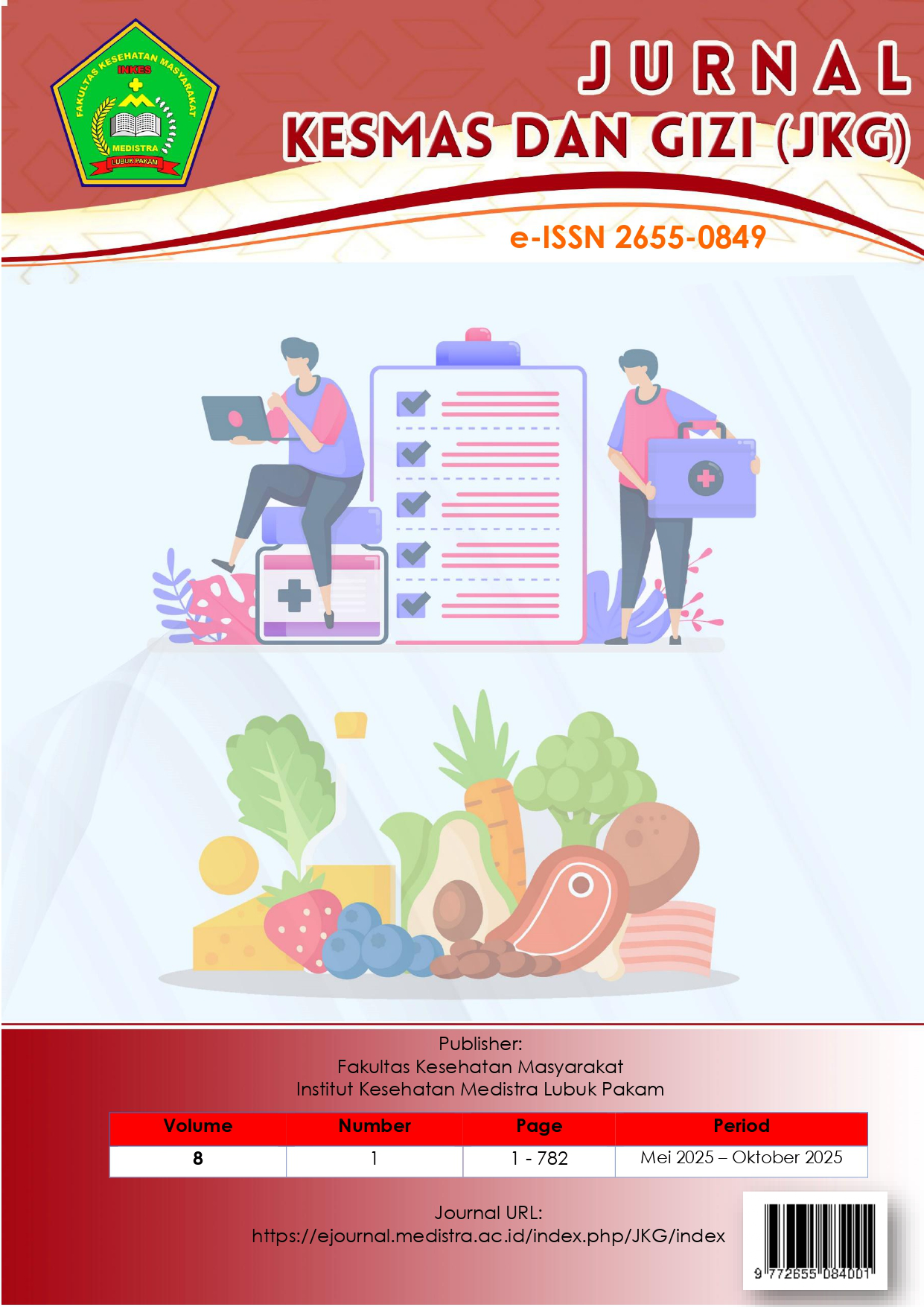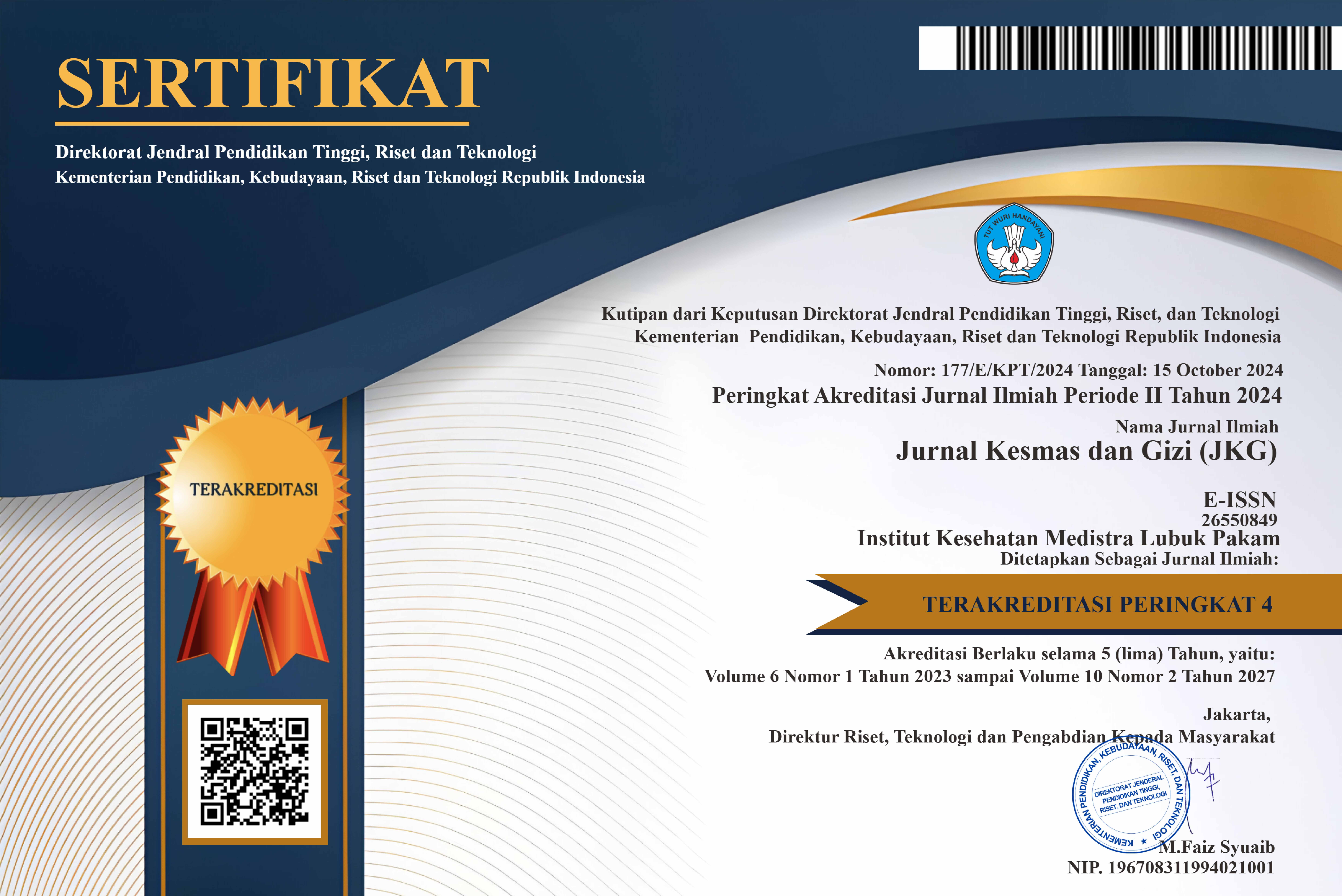Trends in Dietary Assessment Methods among Adolescents in Indonesia: A Narrative Review
DOI:
https://doi.org/10.35451/33b53h89Keywords:
dietary assessment, adolescent, FFQ, 24-hour dietary recall, IndonesiaAbstract
Adolescent malnutrition remains a major public health challenge in Indonesia. Accurate dietary assessment plays a critical role in understanding adolescents’ eating patterns and their implications for nutritional status. This study aimed to identify trends in dietary assessment methods used in adolescent research in Indonesia, focusing on method variation, data collection approaches, and validation of instruments. A narrative review was conducted by screening relevant articles according to inclusion criteria, resulting in 22 eligible studies. The findings show that the most frequently used method was the Food Frequency Questionnaire (FFQ) or Semi-Quantitative FFQ (SQ-FFQ) applied in 12 studies, followed by 24-hour dietary recall, either used alone or in combination. Other methods included food records, the Dietary Quality Index for Adolescent (DQI-A), and the Dietary Diversity Score (DDS). FFQ was reported as practical and cost-effective, although most studies did not mention instrument validation. In contrast, the 24-hour dietary recall provided detailed dietary intake but required more resources and was limited by respondents’ recall ability. Combining methods, such as 24-hour recall with FFQ or food record, improved validity but increased complexity. In conclusion, dietary assessment methods in adolescent studies in Indonesia are predominantly based on FFQ and 24-hour recall, with limited evidence of validation, highlighting the need for greater methodological rigor to ensure accurate dietary assessment among adolescent.
Downloads
References
[1] Das JK, Salam RA, Thornburg KL, Prentice AM, Campisi S, Lassi ZS, et al. Nutrition in adolescents: physiology, metabolism, and nutritional needs. Ann N Y Acad Sci. 2017;1393(1):21–33.
[2] Story, M. Nutritional requirements during adolescence In Textbook of Adolescent Medicine. E.R. McAnarney, R.E. Kreipe, D.E. Orr & G.D. Comerci, Eds.: 75–84. Saunders. 1992.
[3] Kementerian Kesehatan Republik Indonesia. Riset Kesehatan Dasar (Riskesdas). 2018.
[4] Kementerian Kesehatan Indonesia. Survey Kesehatan Indonesia (SKI). 2023.
[5] Awasthi S, Kumar D, Dixit S, Mahdi AA, Gupta B, Agarwal GG, et al. Association of dietary intake with micronutrient deficiency in Indian school children: a cross-sectional study. J Nutr Sci. 2023 Oct 2;12:e104.
[6] Knijff M, Roshita A, Suryantan J, Izwardy D, Rah JH. Frequent Consumption of Micronutrient-Rich Foods Is Associated With Reduced Risk of Anemia Among Adolescent Girls and Boys in Indonesia: A Cross-Sectional Study. Food Nutr Bull. 2021 June 1;42(1_suppl):S59–71.
[7] Bailey RL. Overview of Dietary Assessment Methods for Measuring Intakes of Foods, Beverages, and Dietary Supplements in Research Studies. Curr Opin Biotechnol. 2021 Aug;70:91–6.
[8] Johansson G, Wikman A, Ahrén AM, Hallmans G, Johansson I. Underreporting of energy intake in repeated 24-hour recalls related to gender, age, weight status, day of interview, educational level, reported food intake, smoking habits and area of living. Public Health Nutr. 2001 Aug;4(4):919–27.
[9] Harrison GG, Galal OM, Ibrahim N, Khorshid A, Stormer A, Leslie J, et al. Underreporting of food intake by dietary recall is not universal: a comparison of data from egyptian and american women. J Nutr. 2000 Aug;130(8):2049–54.
[10] Burrows TL, Ho YY, Rollo ME, Collins CE. Validity of Dietary Assessment Methods When Compared to the Method of Doubly Labeled Water: A Systematic Review in Adults. Front Endocrinol. 2019 Dec 17;10:850.
[11] Pérez-Rodrigo C. Dietary Assessment in Children and Adolescents: Issues and Recommendations. Nutr Hosp. 2015 Feb 26;(3):76–83.
[12] Sherwood NE. Diet Assessment in Children and Adolescents. In: Jelalian E, Steele RG, editors. Handbook of Childhood and Adolescent Obesity [Internet]. Boston, MA: Springer US; 2008 [cited 2025 Aug 20]. p. 73–89. Available from: https://doi.org/10.1007/978-0-387-76924-0_6
[13] Rankin PPD R PhD(Nutr), D, Hanekom RD(SA) P Sm, Wright RD(SA) P Hh, MacIntyre PhD(Nutr) U. Dietary assessment methodology for adolescents: a review of reproducibility and validation studies. South Afr J Clin Nutr. 2010 Jan 1;23(2):65–74.
[14] Murni IK, Sulistyoningrum DC, Susilowati R, Julia M, Dickinson KM. The association between dietary intake and cardiometabolic risk factors among obese adolescents in Indonesia. BMC Pediatr. 2022 May 12;22:273.
[15] Sari P, Herawati DMD, Dhamayanti M, Hilmanto D. The Study of Nutrient Intake and Adolescent Girls’ Quality of Life in a Rural Area of Indonesia. Children. 2022 Aug 19;9(8):1248.
[16] Mahriani Y, Indriyanti R, Musnamirwan IA, Setiawan AS. A cross-sectional study on dietary assessment, oral hygiene behavior, and oral health status of adolescent girls. Front Nutr. 2022 Oct 5;9:973241.
[17] Yulia C, Rosdiana DS, Muktiarni M, Sari DR. Reflections of well-being: navigating body image, chronic energy deficiency, and nutritional intake among urban and rural adolescents. Front Nutr. 2024 May 1;11:1346929.
[18] Penggalih MHS, Juffrie M, Sudargo T, Sofro ZM. Correlation Between Dietary Intake with Anthropometry Profile on Youth Football Athlete in Indonesia. Asian J Clin Nutr. 2016 Dec 15;9(1):9–16.
[19] Penggalih MHST, Isnanta R, Rahadian B, Margono M, Sujadi D, Wicaksari SA, et al. Association between Nutrient Intake and Height among Adolescent Athlete in Indonesia: A Cross-Sectional Study. Amerta Nutr. 2024 Mar 8;8(1):40–8.
[20] Knijff M, Roshita A, Suryantan J, Izwardy D, Rah JH. Frequent Consumption of Micronutrient-Rich Foods Is Associated With Reduced Risk of Anemia Among Adolescent Girls and Boys in Indonesia: A Cross-Sectional Study. Food Nutr Bull. 2021 June 1;42(1_suppl):S59–71.
[21] Atmaka DR, Ningsih WIF, Maghribi R. Dietary intake changes in adolescent girl after iron deficiency anemia diagnosis. Health Sci J Indones. 2020 June 29;11(1):27–31.
[22] Azrimaidaliza, Syahrial, Masrizal. Profile of Macro-Nutrient Intake and Its Association with Undernutrition Prevalence Among Adolescent Girls in Rural Areas of The Western Sumatera. Nutr Clínica Dietética Hosp [Internet]. 2024 Nov 27 [cited 2025 Aug 25];44(4). Available from: https://revista.nutricion.org/index.php/ncdh/article/view/762
[23] Oy S, Witjaksono F, Mustafa A, Setyobudi SI, Fahmida U. Problem Nutrients in Adolescent Girls With Anemia Versus Nonanemic Adolescent Girls and the Optimized Food-Based Recommendations to Meet Adequacy of These Nutrients in Adolescent School Girls in East Java, Indonesia. Food Nutr Bull. 2019 Sept 1;40(3):295–307.
[24] Primalova A, Stefani M. The Relationship between Nutritional Status, Junk Food Consumption, and Exercise Habits of Adolescent Girls in Jakarta with the Incidence of Primary Dysmenorrhea. Amerta Nutr. 2024 Mar 8;8(1):104–15.
[25] Wahyurin IS, Rahmah HA. Amount of Menstrual Blood and Nutrient Intake with Hemoglobin Level. J Kesehat Masy. 2021 July 24;17(1):31–6.
[26] Lilik Hidayanti, Dian Saraswati, Iseu Siti Aisyah. Associations between quantity and quality of dietary intake with haemoglobin concentration among female adolescents in Tasikmalaya, West Java, Indonesia. Malays J Nutr. 2024 Apr 26;30(1):087–94.
[27] Ulfah Utami, Ary Agustanti, Yuanita Lely Rachmawati, Febriana Setiawati, Yasemin Yavuz, Alessandro Leite Cavalcanti, et al. Food Consumption Frequency and Dental Caries Status among Adolescents in Jakarta. J Int Dent Med Res. 2020;13(3):1054–8.
[28] Giyawati Yulilania Okinarum, Fresthy Astrika Yunita, Hardiningsih, Afroh Fauziah, Alva Cherry Mustamu. Monthly household income and intake of nutrients among adolescent females in a rural setting of Indonesia. Int J Health Sci IJHS. 2022 Apr 7;6(S4):675–83.
[29] Rika Rachmalina, Helda Khusun, Luluk Basri Salim, Luh Ade Ari Wiradnyani, Drupadi HS Dillon. Comparing intake adequacy and dietary diversity between adolescent schoolgirls with normal nutritional status (NG) and undernutrition (UG) based on BMI-for- age (BAZ) living in urban slums in Central Jakarta. Malays J Nutr. 2019;25:19–32.
[30] Dwijayanti I, Chien YW, Poda GG, Chao JCJ. Defining food literacy and dietary patterns among senior high school students in Malang City, East Java. J Gizi Indones Indones J Nutr. 2021 Dec 22;10(1):45–53.
[31] Lalusu EY, Ramli R, Sattu M, Lanyumba FS, Otoluwa AS. Unhealthy Food Consumption Pattern and Nutritional Status among Adolescents: A Cross-sectional Study. Open Access Maced J Med Sci. 2022 Jan 1;10(E):349–54.
[32] Fitripancari AD, Arini FA, Imrar IF, Maryusman T. The Relationship between Iron and Vitamin C Intake, Risk Beverage Consumption Frequency, and Dietary Behavior with Anemia Adolescent Girls in Depok City. Amerta Nutr. 2023 Dec 31;7(2SP):100–6.
[33] Khoirunnisa M, Devaera Y, Fahmida U, Witjaksono F, Prafiantini E. Protein and iron intake adequacy among high school girls in Depok, Indonesia. World Nutr J. 2021 Aug 27;4(2):18–25.
[34] Huwaida DZ, Dewi YLR, Kusnandar K. Unhealthy Diet and Stress are Correlated with Premenstrual Syndrome in Adolescent Girls in Tangerang. Media Gizi Indones. 2022 May 30;17(2):168–73.
[35] Rahmawati DP, Indarto D, Hanim D. Fast Food Consumption and Snacking in Female Adolescents and Their Correlation With Hemoglobin Levels. In Atlantis Press; 2021 [cited 2025 Aug 18]. p. 113–6. Available from: https://www.atlantis-press.com/proceedings/ahms-20/125951852
[36] Coates RJ, Monteilh CP. Assessments of food-frequency questionnaires in minority populations. Am J Clin Nutr. 1997 Apr;65(4 Suppl):1108S-1115S.
[37] Cade J, Thompson R, Burley V, Warm D. Development, validation and utilisation of food-frequency questionnaires – a review. Public Health Nutr. 2002 Aug;5(4):567–87.
[38] Viau KS, Ernst SL. Food Frequency Questionnaire: An Alternative Method to Assess Protein Intake in Adolescents and Adults With Phenylketonuria. Top Clin Nutr. 2014 Dec;29(4):332.
[39] Haftenberger M, Heuer T, Heidemann C, Kube F, Krems C, Mensink GB. Relative validation of a food frequency questionnaire for national health and nutrition monitoring. Nutr J. 2010 Sept 14;9:36.
[40] Cui Q, Xia Y, Wu Q, Chang Q, Niu K, Zhao Y. Validity of the food frequency questionnaire for adults in nutritional epidemiological studies: A systematic review and meta-analysis. Crit Rev Food Sci Nutr. 2023 May 7;63(12):1670–88.
[41] Turconi G, Bazzano R, Roggi C, Cena H. Reliability and relative validity of a quantitative food-frequency questionnaire for use among adults in Italian population. Int J Food Sci Nutr. 2010 Dec 1;61(8):846–62.
[42] Guerrero RTL, Chong M, Novotny R, Wilkens LR, Badowski G, Blas-Laguana M, et al. Relative validity and reliability of a quantitative food frequency questionnaire for adults in Guam. Food Nutr Res. 2015 May 5;59:10.3402/fnr.v59.26276.
[43] Livingstone MBE, Robson PJ. Measurement of dietary intake in children. Proc Nutr Soc. 2000 May;59(2):279–93.
[44] Livingstone, M B E; Robson, P J; Wallace, J M W. Issues in dietary intake assessment of children and adolescents. Br J Nutr. 2024 Oct;92(S2):S231-22.
[45]Dietary Assessment Primer [Internet]. [cited 2025 Aug 22]. Available from: https://dietassessmentprimer.cancer.gov/
[46] Folson GK, Bannerman B, Atadze V, Ador G, Kolt B, McCloskey P, et al. Validation of Mobile Artificial Intelligence Technology–Assisted Dietary Assessment Tool Against Weighed Records and 24-Hour Recall in Adolescent Females in Ghana. J Nutr. 2023 Aug 1;153(8):2328–38.
[47] Principles Underlying Recommendations | Dietary Assessment Primer [Internet]. [cited 2025 Aug 22]. Available from: https://dietassessmentprimer.cancer.gov/approach/principles.html
[48] Moshfegh AJ, Rhodes DG, Baer DJ, Murayi T, Clemens JC, Rumpler WV, et al. The US Department of Agriculture Automated Multiple-Pass Method reduces bias in the collection of energy intakes. Am J Clin Nutr. 2008 Aug;88(2):324–32.
[49] Kreuter F, Presser S, Tourangeau R. Social Desirability Bias in CATI, IVR, and Web Surveys: The Effects of Mode and Question Sensitivity. Public Opin Q. 2008 Dec 1;72(5):847–65.
[50] Cade JE, Burley VJ, Warm DL, Thompson RL, Margetts BM. Food-frequency questionnaires: a review of their design, validation and utilisation. Nutr Res Rev. 2004;17(1):5–22.
[51] de Boer EJ, Slimani N, van ’t Veer P, Boeing H, Feinberg M, Leclercq C, et al. The European Food Consumption Validation Project: conclusions and recommendations. Eur J Clin Nutr. 2011 July;65(1):S102–7.
[52] Beaton GH, Milner J, McGuire V, Feather TE, Little JA. Source of variance in 24-hour dietary recall data: implications for nutrition study design and interpretation. Carbohydrate sources, vitamins, and minerals. Am J Clin Nutr. 1983 June;37(6):986–95.
[53] Tarasuk V, Beaton GH. The nature and individuality of within-subject variation in energy intake. Am J Clin Nutr. 1991 Sept;54(3):464–70.
[54] Park Y, Dodd KW, Kipnis V, Thompson FE, Potischman N, Schoeller DA, et al. Comparison of self-reported dietary intakes from the Automated Self-Administered 24-h recall, 4-d food records, and food-frequency questionnaires against recovery biomarkers. Am J Clin Nutr. 2018 Jan;107(1):80–93.
[55] Freedman LS, Commins JM, Moler JE, Arab L, Baer DJ, Kipnis V, et al. Pooled Results From 5 Validation Studies of Dietary Self-Report Instruments Using Recovery Biomarkers for Energy and Protein Intake. Am J Epidemiol. 2014 July 15;180(2):172–88.
[56] Freedman LS, Commins JM, Moler JE, Willett W, Tinker LF, Subar AF, et al. Pooled Results From 5 Validation Studies of Dietary Self-Report Instruments Using Recovery Biomarkers for Potassium and Sodium Intake. Am J Epidemiol. 2015 Apr 1;181(7):473–87.
[57] Tabacchi G, Garbagnati F, Wijnhoven TMA, Cairella G, Alicante P, Blasio FD, et al. Dietary assessment methods in surveillance systems targeted to adolescents: A review of the literature. Nutr Metab Cardiovasc Dis. 2019 Aug 1;29(8):761–74.
[58] Wa WSR, Ts HP, NirmaliWickramaratne M. A comprehensive review on dietary assessment methods in epidemiological research. In 2020 [cited 2025 Aug 22]. Available from: https://www.semanticscholar.org/paper/A-comprehensive-review-on-dietary-assessment-in-Wa-Ts/e1fa7bd28714f1b819316ab7006636d562080bdc
[59] Simatupang AM, Dewi YLR, Andayani TR. Accuracy of Dietary Assessment Methods as a Measurement of Micronutrient Intake in Adolescents: Scoping Review. Amerta Nutr. 2024 Nov 22;8(4):642–53.
Downloads
Published
Issue
Section
License
Copyright (c) 2025 Tazkia Putri Kagami

This work is licensed under a Creative Commons Attribution 4.0 International License.
Copyright in each article is the property of the Author.


























